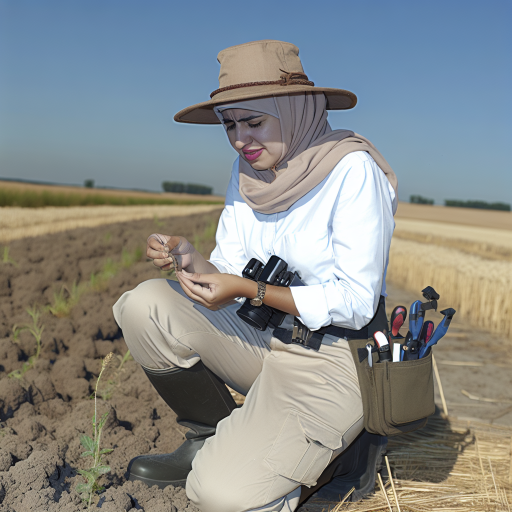Introduction:
Global market trends in agriculture play a crucial role in shaping economies worldwide.
Agriculture is the backbone of many countries’ economies.
It provides food, employment, and raw materials for various industries.
In developing countries, agriculture is often the primary source of income for a large percentage of the population.
Therefore, any shifts or changes in global market trends in agriculture can have a significant impact on the overall economic stability of these nations.
Moreover, agriculture is not just about producing food.
It also encompasses the production of raw materials for industries such as textiles, pharmaceuticals, and biofuels.
As a result, fluctuations in global market trends in agriculture can affect various sectors of the economy beyond just the agricultural sector.
Given these intertwined relationships, keeping a close eye on global market trends in agriculture is essential for policymakers, investors, and stakeholders alike.
Understanding how these trends evolve can help in making informed decisions that will ultimately impact the economic prosperity of nations around the world.
Increasing demand for organic produce:
In recent years, there has been a noticeable surge in consumer demand for organic fruits and vegetables.
This trend is not limited to a specific region but is being witnessed globally.
Consumers are becoming increasingly health-conscious and are willing to pay a premium for organically grown produce.
Discussion on the rise in consumer demand:
- Consumers are becoming more aware of the harmful effects of pesticides and synthetic chemicals used in conventional farming.
- Organic produce is seen as a healthier choice as it is free from harmful chemicals and pesticides.
- The trend is further fueled by the increasing focus on sustainability and environmental conservation.
- Many consumers are also concerned about animal welfare and opt for organic products that are cruelty-free.
Explanation on how this trend is driving growth:
- The growing demand for organic produce has led to an expansion of organic farming practices.
- Farmers are transitioning from conventional farming to organic methods to meet the market demand.
- This shift has created new opportunities for farmers and has contributed to the growth of the agricultural sector.
- Increased demand for organic products has also led to the development of new technologies and practices in agriculture.
Examples of countries where organic farming is popular:
- Germany: Germany is one of the leading countries in organic farming with a significant market share.
- United States: The US market for organic products has been steadily growing, driven by consumer demand.
- France: France has seen a rise in organic farming, with more farmers transitioning to organic practices.
- Australia: Organic farming is gaining popularity in Australia, with a growing number of organic farms.
Technological advancements in agriculture:
Technology has played a significant role in transforming the agricultural sector in recent years.
From precision farming techniques to the use of artificial intelligence, farmers are harnessing the power of technology to improve efficiency and sustainability in their operations.
- Explore how technology is revolutionizing farming practices.
- Discuss the use of drones, AI, and precision farming techniques.
- Highlight the benefits of technology for increasing productivity and sustainability.
One of the most notable advancements in agriculture is the use of drones.
These unmanned aerial vehicles are equipped with cameras and sensors that can provide real-time data on crop health, soil moisture levels, and pest infestations.
Farmers can use this information to make informed decisions about irrigation, fertilization, and pest control, ultimately leading to higher yields and reduced environmental impact.
Artificial intelligence (AI) is another game-changer in agriculture.
By analyzing large amounts of data, AI technology can help farmers optimize their planting schedules, predict crop yields, and identify potential disease outbreaks.
Transform Your Career Today
Unlock a personalized career strategy that drives real results. Get tailored advice and a roadmap designed just for you.
Start NowThis not only increases productivity but also reduces the reliance on pesticides and other chemicals, promoting sustainable farming practices.
Precision farming techniques, such as GPS-guided tractors and automated irrigation systems, have also revolutionized the way crops are grown.
By precisely targeting inputs like water, nutrients, and pesticides, farmers can minimize waste and maximize yields.
This not only saves time and money but also helps protect the environment by reducing water pollution and soil erosion.
The benefits of technology in agriculture are numerous.
By increasing productivity, technology enables farmers to produce more food with fewer resources, helping to feed a growing global population.
Additionally, technology promotes sustainability by minimizing the environmental impact of farming practices, such as reducing greenhouse gas emissions and conserving natural resources.
Technological advancements in agriculture are shaping the future of farming.
From drones to AI to precision farming techniques, technology is helping farmers work smarter, not harder, to meet the challenges of a changing world.
By embracing these advancements, farmers can increase productivity, improve sustainability, and ensure food security for generations to come.
You Might Also Like: Quality Control Inspector’s Role in Grain Inspection
Shift towards plant-based proteins:
In recent years, there has been a significant shift towards plant-based proteins as consumers become more conscious of their health and the environmental impact of animal agriculture.
This trend has been driven by a growing awareness of the negative effects of meat consumption on personal health and the planet.
People are opting for plant-based diets for various reasons, including ethical, environmental, and health concerns.
As the popularity of plant-based diets continues to rise, there has been a noticeable impact on the agriculture industry, particularly in protein production.
Traditional livestock farming practices are being challenged as consumers seek more sustainable alternatives that are better for both the planet and their health.
This shift has led to the emergence of innovative plant-based protein sources, such as soy, legumes, and quinoa, that are being used as substitutes for animal proteins.
Farmers are adapting to this changing landscape by diversifying their crops and exploring new ways to meet the demand for plant-based proteins.
Many farmers are incorporating plant-based protein crops into their rotations and exploring regenerative agriculture practices to improve soil health and reduce the need for synthetic fertilizers and pesticides.
Some farmers are also embracing agroforestry systems, which combine trees with agricultural crops to create a more sustainable and biodiverse farming environment.
Transform Your Career Today
Unlock a personalized career strategy that drives real results. Get tailored advice and a roadmap designed just for you.
Start NowIn response to the growing interest in plant-based proteins, the agriculture industry is investing in research and development to improve the efficiency and sustainability of protein production.
This includes developing new plant-based protein sources, such as pea protein and hemp protein, that are more cost-effective and environmentally friendly than traditional animal protein sources.
Additionally, there is a focus on improving the taste and texture of plant-based protein products to appeal to a wider range of consumers.
The shift towards plant-based proteins is reshaping the agriculture industry and providing new opportunities for farmers to meet the evolving demands of consumers.
By embracing this trend and adapting their practices to align with consumer preferences, farmers can play a crucial role in promoting sustainable and healthy food choices for a changing world.
- Analyze the growing popularity of plant-based diets
- Discuss the impact on the agriculture industry, particularly in protein production
- Examine how farmers are adapting to meet the demand for plant-based proteins
Find Out More: How to Inspire Students in Agricultural Science
Global trade agreements and tariffs:
Trade agreements play a significant role in shaping agricultural markets globally.
They establish rules and guidelines that govern the trade of agricultural products.
Through trade agreements, countries can negotiate terms for market access and reduce barriers.
These agreements promote international cooperation and create a more predictable trading environment.
For example, the WTO ensures fair trade practices through agreements like the Agreement on Agriculture.
Impact of trade agreements on agricultural markets:
- Trade agreements can increase market access for agricultural products, benefiting farmers and consumers.
- They can also lead to greater competition, driving innovation and productivity in the agricultural sector.
- However, trade agreements can also pose challenges for farmers, especially in developing countries.
- Liberalization of trade can expose farmers to price volatility and increased competition from imports.
- Overall, the impact of trade agreements on agricultural markets depends on how they are structured and implemented.
Impact of tariffs on international trade of agricultural products:
- Tariffs are taxes imposed on imported goods, which can impact the flow of agricultural products globally.
- They can increase the cost of imported agricultural products, making them less competitive in the market.
- Tariffs can also lead to retaliatory measures by trading partners, affecting the overall trade relationship.
- For instance, the US-China trade war resulted in higher tariffs on agricultural products like soybeans.
- High tariffs can disrupt supply chains and create uncertainties for farmers and food processors.
Political decisions shaping global market trends in agriculture:
- Political decisions, such as sanctions or trade restrictions, can have a significant impact on agricultural markets.
- For example, bans on certain agricultural imports can disrupt market dynamics and supply chains.
- Political instability can also create uncertainties for investors and businesses in the agriculture sector.
- Moreover, trade negotiations and agreements are influenced by political decisions and considerations.
- Thus, political stability and cooperation are essential for fostering growth and stability in global agricultural markets.
Delve into the Subject: Biotechnology and the Future of Farming Practices

Climate change and sustainable farming practices:
Explain how climate change is affecting agriculture worldwide
Climate change is causing more extreme weather events, droughts, and floods.
This leads to crop failures, soil degradation, and loss of biodiversity.
Farmers are facing challenges in adapting to unpredictable weather patterns.
Discuss the importance of adopting sustainable farming practices
Sustainable farming practices help mitigate the effects of climate change.
They promote soil health, water conservation, and reduce greenhouse gas emissions.
Adopting sustainable practices ensures long-term food security and environmental sustainability.
Provide examples of countries leading the way in sustainable agriculture
- The Netherlands is known for its innovative greenhouse farming techniques.
- Denmark has a strong focus on organic farming and reducing chemical inputs.
- Costa Rica has implemented policies to promote agroforestry and biodiversity conservation.
Addressing climate change through sustainable farming practices is crucial for the future of agriculture.
By adopting environmentally friendly techniques, countries can ensure food security while minimizing the impact on the planet.
Transform Your Career Today
Unlock a personalized career strategy that drives real results. Get tailored advice and a roadmap designed just for you.
Start NowIt is essential for governments, farmers, and consumers to work together to promote sustainable agriculture and secure a prosperous future for generations to come.
Find Out More: Poultry Farming Trends and Poultry Scientists
Emerging markets in agriculture:
Emerging markets in agriculture are regions with high growth potential and increasing opportunities for farmers in developing countries.
These markets are characterized by rapid economic development, urbanization, and changing dietary preferences.
Highlight the growth potential of emerging markets in agriculture:
- Emerging markets offer a vast potential for agricultural growth due to rising incomes and changing consumption patterns.
- These markets provide opportunities for farmers to diversify their crops and explore new markets for their products.
- The adoption of technology and innovation in agriculture can help boost productivity and efficiency in emerging markets.
Discuss the challenges and opportunities for farmers in developing countries:
- Challenges faced by farmers in developing countries include limited access to finance, lack of infrastructure, and climate change impact.
- Opportunities for farmers in these countries include expanding market access through e-commerce and digital platforms, sustainable agriculture practices, and value-added products.
- Improving infrastructure, such as roads and storage facilities, can help farmers in developing countries access markets more easily and increase their profitability.
Analyze the impact of global market trends on these emerging markets:
- Global market trends such as trade agreements, climate change policies, and consumer preferences can have a significant impact on emerging markets in agriculture.
- Changes in consumer preferences towards organic and locally sourced products present opportunities for farmers in emerging markets to differentiate their products and command higher prices.
- Trade agreements can open up new export markets for farmers in developing countries, but at the same time, they may face challenges in meeting international quality and safety standards.
Growth Opportunities in Agriculture:
Emerging markets in agriculture offer great potential for growth and opportunities for farmers in developing countries.
By addressing the challenges they face, leveraging global market trends, and adopting innovative practices, farmers in these markets can thrive and contribute to the sustainable development of the agriculture sector worldwide.
Understanding Global Market Trends in Agriculture
Understanding global market trends in agriculture is crucial for farmers and stakeholders.
Keeping abreast of these trends can help in making informed decisions and staying competitive in the industry.
By staying informed, individuals can capitalize on emerging opportunities and navigate challenges more effectively.
It is essential to monitor global market dynamics to adapt to changing consumer preferences, technological advancements, and regulatory changes.
Staying informed about global market trends in agriculture is key to success in the evolving agricultural landscape.
All readers are encouraged to explore the various opportunities presented by these trends.
Whether it’s investing in sustainable practices, leveraging technology for efficiency, or tapping into new markets, there are numerous ways to thrive in today’s agricultural environment.
By embracing change and innovation, individuals can position themselves for success and contribute to the sustainability of the agricultural sector.
Embracing these opportunities will not only benefit individual businesses but also contribute to the overall growth and development of the global agriculture industry.
Additional Resources
Grain: World Markets and Trade
USDA-Agricultural-Projections-to-2032.pdf
[E-Books for Sale]
The Big Book of 500 High-Paying Jobs in America: Unlock Your Earning Potential
$19.99 • 500 High-Paying Jobs • 330 pages
Explore 500 high-paying jobs in America and learn how to boost your career, earn more, and achieve success!
See All 500 High-Paying Jobs of this E-Book
1001 Professions Without a Degree: High-Paying American Jobs You Can Start Now
$19.99 • 1001 Professions Without a Degree • 174 pages
Discover 1001 high-paying jobs without a degree! Unlock career tips, skills, and success strategies for just $19.99!




